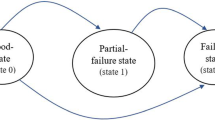Abstract
This paper discussed the MTSF and profit analysis of a single-unit system with inspection for feasibility of repair beyond warranty subject to a single repair facility. Any failure during warranty is rectified by the manufacturer free of cost to the users provided failures are not due to the negligence of users. Beyond warranty, unit goes under inspection after failure for feasibility of its repair or replacement. The failure time of the system follows negative exponential distribution while repair and inspection time distributions are taken as arbitrary. The expressions for reliability, MTSF, availability of the system and profit function have been determined by using supplementary variable technique. Using Abel’s lemma steady state behavior of the system has been derived. The numerical results for reliability and profit function are also obtained by taking particular values of various parameters and repair cost.
Similar content being viewed by others
Refrences
Balagurusamy E (2009) Reliability engineering. McGraw-Hill, New York
Cox DR (1962) Renewal theory. John Wiley & Sons INC, New York
Jin X, Lin Li, Jun Ni (2009) Option model for joint production and preventive maintenance system. Inter J Prod Econ 119:347–353
Kadyan MS, Promila Kumar J (2013) Reliability modeling of a single-unit system with arbitrary distribution subject to different weather condition. Int J Syst Assur Eng Manag 5(3):313–319
Kaur M, Lal AK, Bhatia SS, Reddy AS (2013) Numerical solution of stochastic partial differential difference equation arising in reliability engineering. Appl Math Comput 219:7645–7652
Kharoufeh JP, Solo CJ, Ulukus MY (2010) Semi-Markov models for degradation-based reliability. IIE Trans 42:599–612
Uematsu K, Nishida T (1987) One-unit system with a failure rate depending upon the degree of repair. Math Jpn 32(1):139–147
Author information
Authors and Affiliations
Corresponding author
Appendices
Appendix
The derivation of Eqs. (1)–(5)
Assuming failure rates of the system are constant and repair rates are arbitrary. By applying supplementary variable technique, we develop the following differential-difference equations associated with the state transition diagram (Fig. 1) of the system at times (t + Δt), (y + Δy) and (x + Δx).
\(p_{1} (t + \varDelta t) = p_{1} (t)\left( {1 - \lambda_{1} \varDelta t} \right) + \alpha p_{0} (t) + \int_{0}^{\infty } {\mu_{1} (x)p_{4} (x,t)\varDelta tdx + } \int_{0}^{\infty } {qh(y)p_{3} (y,t)\varDelta tdy + o(\varDelta t),}\) \(p_{2} (x + \varDelta x,t + \varDelta t) = p_{2} (x,t)\left( {1 - \mu (x)\varDelta x} \right) + o\left( {\varDelta x,\varDelta t} \right),\)
The proof of Theorem-1
Proof
Taking Laplace transforms of Eqs. (38) and (39), using (9), we get
The solution can be written as
Taking inverse Laplace transform, we get
Rights and permissions
About this article
Cite this article
Niwas, R., Kadyan, M.S. & Kumar, J. MTSF (mean time to system failure) and profit analysis of a single-unit system with inspection for feasibility of repair beyond warranty. Int J Syst Assur Eng Manag 7 (Suppl 1), 198–204 (2016). https://doi.org/10.1007/s13198-015-0362-6
Received:
Published:
Issue Date:
DOI: https://doi.org/10.1007/s13198-015-0362-6





